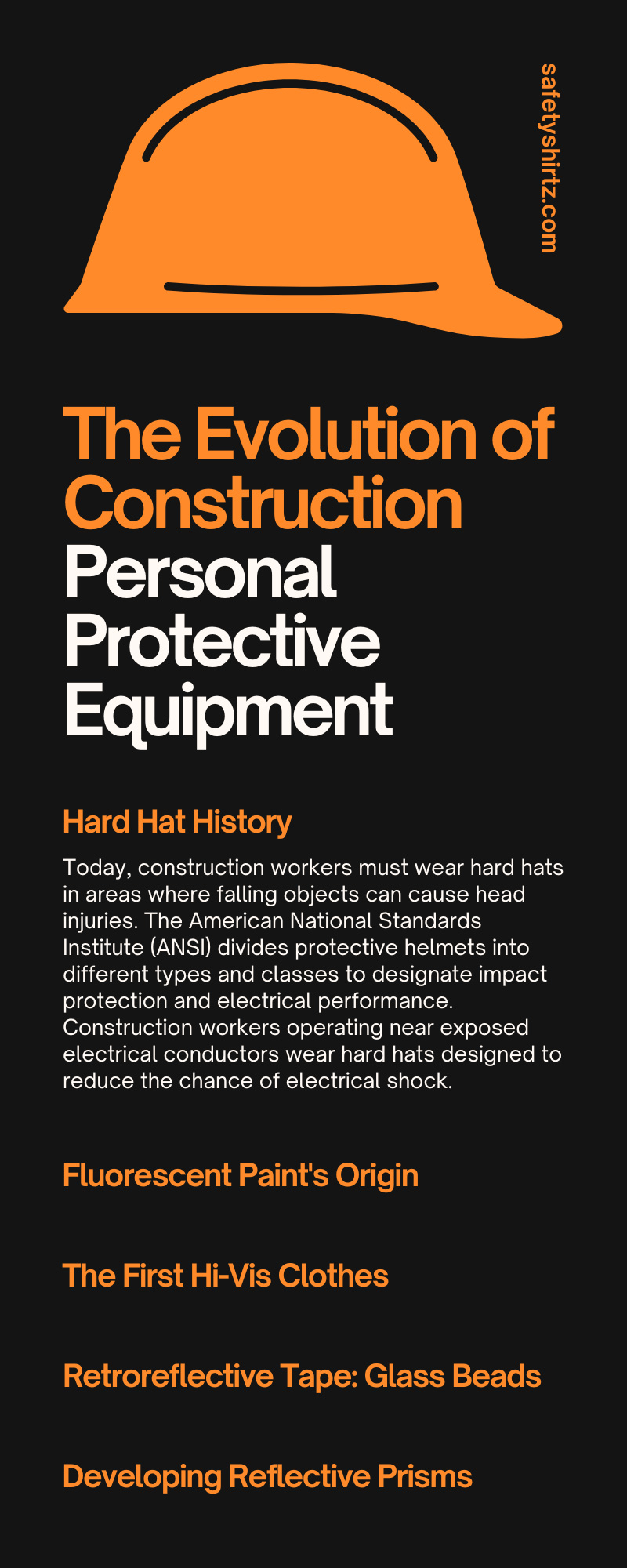The Evolution of Construction Personal Protective Equipment
28th Feb 2023
Some of the most common personal protective equipment (PPE) construction workers wear are hard hats and hi-vis safety clothes. Read about the evolution of construction personal protective equipment to understand these two safety gear essentials.
Hard Hat History
Today, construction workers must wear hard hats in areas where falling objects can cause head injuries. The American National Standards Institute (ANSI) divides protective helmets into different types and classes to designate impact protection and electrical performance. Construction workers operating near exposed electrical conductors wear hard hats designed to reduce the chance of electrical shock.
The hard hat has evolved since its introduction over a century ago. The Bullard Manufacturing Company, based in San Francisco, California, created the first commercially available industrial head protection. They started manufacturing their product in the late 1800s.
Bullard sold hard hats mainly to miners. In 1919, the company manufactured the Hard Boiled hat made from steamed canvas, glue, and black paint. The hat was trademarked with that name because the manufacturing process used steam. Companies could mount a leather and metal lamp bracket to the front of the hat to hold a miner's lamp.
A construction company created the first designated hard hat area in a U.S. construction job site during the building of the Golden Gate Bridge in San Francisco from 1933-1937. Falling rivets created a safety hazard. The Bullard company modified their mining helmet, and workers were required to wear hard hats and follow other safety practices to retain employment.
Designers needed to create durable yet lightweight protective headgear. In 1938, Bullard designed and manufactured the first aluminum hard hat. While the hat was light, it conducted electricity, so it was soon replaced by heat-resistant fiberglass. In the 1950s, thermoplastics replaced fiberglass as a superior and cost-effective alternative.
The modern-day standard hat was designed in 1982. The outside shells of today's hard hats typically consist of high-density polyethylene (HDPE) or polycarbonate resin. These are strong, lightweight materials that fabricators can easily mold, and they do not conduct electricity.
Fluorescent Paint's Origin
High-visibility clothing such as safety vests, shirts, and pants protect construction workers on every job site. The bright, fluorescent color of hi-vis clothes helps workers stand out from their background environment. Key factors in creating hi-vis clothing began with the work of two brothers.
Robert "Bob" Switzer co-invented the first black light fluorescent paint with his brother, Joseph Switzer. In 1933, Bob Switzer was unloading tomatoes from a freight car when he fell and suffered serious injuries, including a skull fracture and a severed optic nerve.
Bob had to recover in a dimly lit environment, and during his recovery, he worked with his brother to investigate fluorescent dyes. He and Joseph searched for fluorescent materials to use in Joseph's amateur magic shows. They used a black light to identify fluorescent compounds in products they found in their father's pharmacy.
After Bob's recovery, the brothers continued experimenting with fluorescent mixtures and eventually produced the first black-light fluorescent paints. They founded Fluor-S-Art Co. in 1934 to develop and market their products for advertising displays.
In 1946, the brothers founded the Day-Glo Color Corp. for fluorescent paints, pigments, and other products. They partnered with Continental Lithograph, a company specializing in movie posters and advertisements, and developed new ways to use fluorescent paints in lithography, makeup, and fabric dyes.
The First Hi-Vis Clothes
Day-Glo paint could make materials shine like they were glowing in daylight. Once they found a stable and safe mixture of Day-Glo, Bob applied it to his wife's wedding dress. The dress became the first hi-vis apparel.
The brothers continued to improve the formula. During WWII, the use of fluorescent pigment for safety grew. The United States Army experienced problems with friendly fire, especially in urban combat zones at night. In the confusion of battle, soldiers would become confused and lose track of the location of their comrades.
The desperate need to reduce injuries and death from friendly fire prompted the U.S. Army to adopt the Switzer brother's invention. The military dipped fabric panels in reflective paint, and military members wore hi-vis fabric while working. Aircraft crew began wearing hi-vis safety vests and pants as they directed planes.
Today, fluorescent fabric is an essential component of high-visibility apparel for construction workers. During the day, the bright color protects workers from collisions with vehicular traffic and heavy moving machinery.
Retroreflective Tape: Glass Beads
While fluorescent fabric enhances visibility in daylight, workers also need increased visibility in low-light conditions, such as at night or in bad weather. The second essential component of hi-vis workwear is retroreflective tape.
Retroreflective material uses tiny glass beads or manufactured prisms to reflect light rather than absorb it. Unlike other reflective materials, retroreflective tape sends the light directly back to the source rather than scattering it. This characteristic is why when someone shines a vehicle's headlights on the material, they see a crisp and stunning glow.
In the 1920s, the popularity of automobiles was growing rapidly, and it became essential to make road signs visible to drivers at night. The first retroreflective signs used large glass beads, but they retroreflected poorly and scattered too much light. In the rain, the glass beads performed even worse.
In the 1940s, 3M developed durable and easy-to-apply retroreflective tape. This new material used micro-sized glass beads fractions of a millimeter wide and reflected light more efficiently. The company applied a metalized layer that made the tape more effective in rain. In addition to application on signs, this product was used on movie screens to make images appear clearer and brighter.
Developing Reflective Prisms
Micro prisms are angled shapes that resemble the corners of a cube. Compared to the round shape of glass beads, micro prisms have a greater percentage of their surface area angled directly toward the light source, which improves reflective capacity.
In the 1970s, the Reflexite corporation began producing micro prism tape. Competing manufacturers began creating their own versions of the highly effective retroreflector. Improvements to retroreflective tape are an important process in the continuing evolution of construction personal protective equipment.
Today, the amount of retroreflective tape and its location on safety apparel is a crucial consideration for classification using ANSI's high visibility standards. Construction personnel working under certain conditions must wear hi-vis workwear that meets specific criteria.
Hi-vis gear protects more effectively now than ever before. SafetyShirtz sells modern high-visibility clothing made with fluorescent fabric, retroreflective tape, and attractive graphic design. Shop today for stylish and essential safety apparel.


